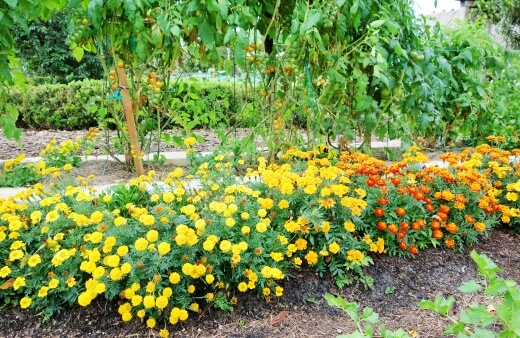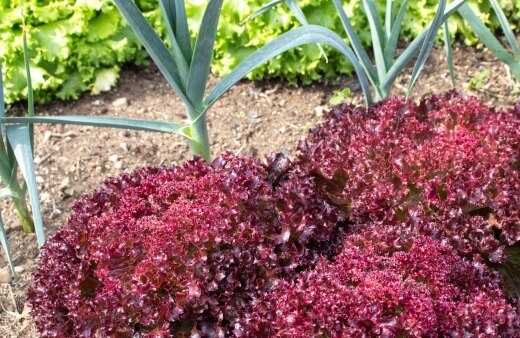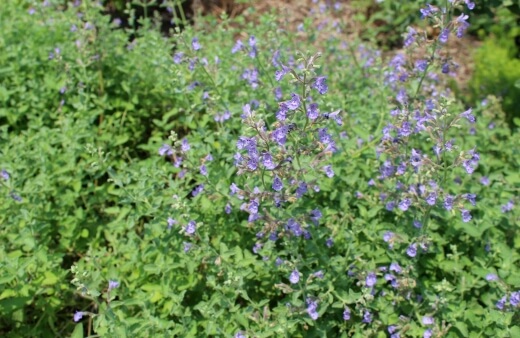Are you having problems with insects eating your plants and veggies? Well, why not add some edible flower companion plants to your veggie patch?
They add a glorious splash of color to your garden whilst also being a great eco-friendly way of deterring insects and pests. It also creates a diverse ecosystem in your veggie patch which promotes the health and growth of the plants.
Not all edible flowers serve as companion plants but there are some edible flowers that do an excellent job at keeping insects and pests away as well as being useful flowers you can eat.
Let's take a closer look at the 5 best edible flower companion plants for vegetable gardens.
More...
What is Companion Planting?

Companion planting is an age-old horticultural practice consisting of planting different crops near one another to create a mutually beneficial relationship. It's like having a gardening wingman to make your life easier!
Benefits of Edible Flower Companion Plants
The benefits of companion planting are many, from soil improvement and space optimization to pest control and improved pollination. Whether you are planting on a small balcony or a large paddock, by providing your veggies with some extra friends, you can reap the benefits and grow a healthy, thriving garden. And you can use both the flowers and veggies!
Improved pollination
Planting brightly coloured edible flowers is an excellent way to attract pollinators to your garden. Bees and butterflies will transport pollen from plant to plant and increase your fruit and vegetable yields.
Pest Control
Unwanted visitors such as aphids and whiteflies are put off by the smell of some edible flowers. By planting the best edible flowers for companion plants, you can create a natural defense system for your plants without using any nasty chemicals or pesticides.
Edible flowers such as chamomile, and cosmos, attract predatory insects such as hoverflies, wasps, and green lacewings. These insects will eat the dreaded aphids and other bugs that look on your veggie patch as a smorgasbord!
Some edible flowers also act as a trap crop or sacrificial plant, which means that the pest will eat the plant first before eating your preferred plant.
Soil Improvement
Edible flowers can also improve the quality of the soil by providing additional rooting systems in the ground. Deep tap roots will help break up compacted soil and improve drainage, whilst plants such as clover will add nitrogen back into the soil.
Space Saving
Companion planting with edible flowers between vegetables helps to make the most of the space you have.
Growing edible flower companion plants with your vegetables means there’s more chance your vegetables will give you a good crop. This occurs through attracting beneficial insects for pollination, acting as sacrificial plants, discouraging harmful pests, and improving soil health.
Top 5 Edible Flower Companion Plants for Vegetable Gardens
Nasturtium (Tropaeolum majus)

Nasturtiums are arguably the most well-known and popular edible flowers. It is native to South and Central American native but is now found all over the world. They are very easy to grow and need very little maintenance.
Nasturtiums are a highly successful companion plant with its abundant and widely vibrant flowers attracting aphids away from veggies and acting as a trap crop. Being a trailing ground cover, they also provide protection against soil water evaporation and weeds.
- Companions: Tomatoes, cucumbers, and radishes, also good to grow with other flowers.
- Deters: Act as a trap plant for Aphids and Whiteflies
- How to grow and care: Nasturtiums prefer a full sun position with well-draining soil but will also tolerate part shade. They can thrive in poor soil conditions and are relatively drought resistant.
This makes them an easy plant to grow as they need very little maintenance. Seeds will take easily sowed in situ and will self-seed if left in the ground after flowering has finished.
Only apply a light fertilizer once at the beginning of the growing season. Don’t over fertilize as this decreases the flower production.
The versatility of nasturtiums is extensive. Learn all about the edible nasturtiums and how to use them here in this post. You will love the pop of vibrant orange and yellow flowers in your edible flower garden as well as being able to use them in many ways in your kitchen.
Marigolds (Tagetes patula)

When it comes to easy edible flowers to grow, Marigolds come out top for both ease and success as a companion plant. They act as a trap crop for the unwanted visitors in your garden, such as earwigs, slugs, and snails.
They are amongst one of the easiest plants to grow and will always seed themselves year after year if not pulled out.
- Companions: basil, broccoli, cabbage, cucumbers, eggplant, gourds, kale, potatoes, squash, and tomatoes.
- Deters: Whiteflies, slugs, snails, and earwigs are repelled by the strong marigold scent. Rabbits, and deer are also deterred by the smell of marigolds. Marigolds attract beneficial insects such as ladybugs and lacewings which love feasting on aphids.
Marigolds also have a positive impact on the health of the soil by releasing chemicals from their roots which are detrimental to nematodes in the soil.
- How to grow and care: Plant in a full sun position with well-draining soil. Marigolds are very easily grown from seed, by sprinkling them on the surface and lightly covering with soil.
If short of space, then plant dwarf varieties or French Marigolds to prevent competing with other plants and nutrients. Water regularly but avoid letting them sit in soaking wet soil to prevent root rot.
Check out our in-depth guide to growing Marigolds in Australia for more details.
Add marigolds as a companion plant to any part of your veggie or edible flower garden and they will really brighten up an otherwise dull-looking space.
Cilantro (Coriandrum sativum)

This Mediterranean herb is also known as Coriander and has an amazing ability to attract insects such as lace wigs and ladybugs. These are natural predators of aphids, spider mites, and other pests that can destroy your precious veggies.
All parts of cilantro are edible, and the dainty flowers make a great garnish for dishes, particularly in Asian cuisines.
- Companions: Leafy vegetables such as lettuce, cabbage, and spinach
- Deters: attracts beneficial insects which feed on aphids, spider mites, potato beetles and cabbage moths
- How to grow and care: As a cool climate plant, cilantro can be grown from seed in a cool sunny spot with partial shade. Use well-draining soil and keep the seeds moist.
Germination of this edible flower companion plant happens after 7-10 days, and within 3-4 weeks, leaves will be ready to harvest. You can also grow cilantro plants from cuttings.
Pop a sprig in a glass of water, in a spot with indirect sunlight, and within a week or 2 it will start growing roots. When the weather warms, cilantro tends to “bolt” and this is when the flowers are produced. Allowing some flowers to go to seed means you can collect these seeds and resow.
One of the more unusual aspects of cilantro is that because it has a long taproot, it helps break up clay soil and improves drainage. This carrot relative is also known to release compounds into the soil that suppresses weed growth- double win!!
Allium – Spring onions, Chives, Garlic, Ornamental alliums

Alliums are one of the best companion flowers for vegetable gardens as well as for many other flowers such as roses and dahlias. Onions, garlic and chives and several globe shaped ornamentals are all part of the genus Allium and have a very pungent aroma. Aphids in particular dislike the strong aroma.
- Companions: Tomatoes, Peppers, Carrots, Beets, Lettuce and Spinach, and in flower gardens with roses and dahlias
- Deters: Aphids, carrot flies, and cabbage worms
- How to grow and care: Plant liberally among your veggies and flowers. Plant spring onions and chives from seeds outdoors in spring. Select a spot that has full sun and well-draining soil.
Grow in containers, garden beds, or directly in the ground. Keep the area free from weeds, water infrequently, and fertilize at the beginning of the growing season.
Alliums are also known to release certain compounds into the soil that can help deter harmful soil-borne pathogens, making them a must-have for your veggie garden.
Spring onions, chives and wild garlic are easy to grow in between your other plants. I usually leave a few of my spring onions and chives in the garden to turn into flowers. I use these to enhance both the flavor and the appearance of any dish that has onions in it.
Catnip (Nepeta cataria)

That's right- Catnip is not just for our feline friends; we can eat it too! But don't worry, we don't get the same effects! You can check here to learn about the benefits of catnip for cats.
This member of the mint family has fragrant purple or white flowers- depending on the variety It is a hardy perennial which can grow up to a meter high in some varieties.
When planted as an edible flower companion plant it attracts beneficial pollinators like bees and butterflies, as well as parasitic wasps. These wasps love caterpillars! So hopefully they will eat them before they get to your cabbages!
Catnip has a mild earthy flavor with mint undertones and can add depth to soups and stews. Mainly used for herbal teas.
- Companions: Cabbage, broccoli, cauliflower and kale, parsley, rosemary, and thyme
- Deters: Flea beetles, ants, termites, and aphids
- How to grow and care: Another edible flower companion plant that is very easy to grow! It thrives in various soil types but adding some compost or well-rotted manure to your native soil will give it an extra boost.
It likes a full sun location and as it matures becomes drought tolerant. Don’t overwater, so plant next to vegetables that don't require a lot of water. It spreads easily and self-seeds easily so make sure you keep its growth in check if you don’t want it to take over!
Catnip has lost some of its popularity recently and I’m not sure why. Being part of the mint family, it can be used as an alternative to mint. It does have a slightly bitter taste though, which brings out other flavors in dishes. The younger leaves can be used in salads and also soups.
Edible Flowers for Companion Plants are the Perfect Match for your veggies!
You can easily add a splash of color to your vegetable patch with these very useful and versatile edible flower companion plants. So next time you're planning your garden, don't forget to add some color.
From the pest-repelling properties of Alliums to the soil-enhancing abilities of cilantro, companion planting with these best edible flower companion plants is a win-win for both you and your plants.
Published on May 19, 2023 by Maisie Blevins
Last Updated on July 2, 2024




